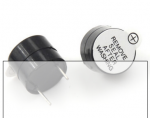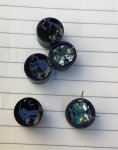Tune Command Output
- Thread starter julianE
- Start date
The sounder you've shown (with the black resin-potted bottom) looks like one I have that is indeed a beeper, i.e. it includes an internal oscillator that generates a tone. I find you can use these to listen to other sounds but they superimpose their internally-generated tone so the output is not as clean as expectedi think it's meant as a stand alone beeper.
Also available are piezo sounders that look very similar but do not generate their own tone. It can be hard to tell which type is being sold. All the beepers I have are potted with black resin in the bottom, all the pure sounders I have do not have this potting, apart from that they look identical - see photo for my limited collection. A non-beeping sounder may give a cleaner sounding output. They are affected by the resonance of their enclosure so to begin with you could try to change this with some electrical tape over the sounding hole or by not removing the 'remove seal after washing' sticker.
But with a little piezo sounder you may always find the output sounds a bit tinny.
Attachments
-
499.3 KB Views: 8
Last edited:
Hi,
Yes, it depends if you have an "Active" (beeper) or a "Passive" (Loudspeaker) type of sounder. Basically, a loudspeaker for use at lower frequencies needs a reasonably-sized "piston" to move the air AND a "baffle" to prevent the sound (air pressure) from the back cancelling out that at the front. An "infinite baffle" is a closed box (except at the front) which needs to be of a reasonable size to prevent the air pressure inside resisting the piston/cone movement. I don't know if your "little cylindrical black box" acts as a baffle or not.
A derivative of the infinite baffle is the "tuned port" (i.e. a hole in the box). The trick is to make the air distance around to the front, a half wavelength of a "wanted" frequency, so that it assists the forward sound. Similarly, you might find that a resonant enclosure (such a a tube or pipe) enhances the sound. I was once very impressed by the pleasing sound from a "ding dong" door alert, which proved to be almost entirely due to a well-designed "enclosure" (box), not the "electronics".
The trick is to make the air distance around to the front, a half wavelength of a "wanted" frequency, so that it assists the forward sound. Similarly, you might find that a resonant enclosure (such a a tube or pipe) enhances the sound. I was once very impressed by the pleasing sound from a "ding dong" door alert, which proved to be almost entirely due to a well-designed "enclosure" (box), not the "electronics".
Cheers, Alan.
Yes, it depends if you have an "Active" (beeper) or a "Passive" (Loudspeaker) type of sounder. Basically, a loudspeaker for use at lower frequencies needs a reasonably-sized "piston" to move the air AND a "baffle" to prevent the sound (air pressure) from the back cancelling out that at the front. An "infinite baffle" is a closed box (except at the front) which needs to be of a reasonable size to prevent the air pressure inside resisting the piston/cone movement. I don't know if your "little cylindrical black box" acts as a baffle or not.
A derivative of the infinite baffle is the "tuned port" (i.e. a hole in the box).
Cheers, Alan.
Thanks Gents.
Alan, brilliant, you anticipated my follow up question. I have a very inexpensive doorbell that works with an RF button that sits outside. the sound is very rich from a tiny speaker and a very small box. I haven't a clue how they achieve so much sound from so little. Also, how do they keep the battery drain so low considering the receiver must be on all the time.I was once very impressed by the pleasing sound from a "ding dong" door alert, which proved to be almost entirely due to a well-designed "enclosure" (box), not the "electronics".
Cheers, Alan.
hippy
Ex-Staff (retired)
I would expect the chip contains a WAV file and simply plays that back.The sound is very rich from a tiny speaker and a very small box. I haven't a clue how they achieve so much sound from so little
My guess would be an extremely low-power circuit in the receiver which only activates the rest when it sees a square wave or whatever coming from the doorbell.Also, how do they keep the battery drain so low considering the receiver must be on all the time.
The doorbell can activate and latch itself on when pushed, send a signal for a second or so once pushed, before dropping to almost zero current again. That gives the doorbell long life because, even though active for a fair time, only activates when pushed.
The long duration of signalling which isn't obvious with a short jab on the doorbell will allow the receiving unit to sleep most of the time, waking up to check for the signal, sleeping again if not seen. Sleeping 99% of the time would give almost a 100 fold increase in battery longevity.
I am not sure how much the actual receiver itself would draw but I can't imagine it would be much, might actually have opportunities for energy harvesting.
Low-cost can be had from mass manufacturing where expensive R&D can be spread to almost nothing per unit across the quantity sold. Mass success often comes from accepting those up-front costs in order to become market leader. Many things like digital photo frames, clocks, and I would guess doorbells, are 'all the same' but with different branding.
Hi,
They normally use one of the VHF ISM radio bands (315/433 MHz), but it's hardly a "Very High Frequency" now, and the receivers may require just a few mA. As hippy says, they only need to switch on for perhaps 10 ms each second, just long enough for their AGC to stabilise and to check for any carrier signal. If there is a carrier, then the receiver can run a little longer to check if it's a relevant transmission.
Personal "Weather Stations" use a slightly different strategy. There, the transmitter power is more critical so they transmit for typically just a few tens of ms exactly every minute (for example). The receiver "learns" the transmission time after its batteries are first inserted (and maybe in request to a "Reset" button or if it can't find any signals for a long period) and then only switches on to "listen" for perhaps one second every minute. Thus both devices need to drain only ~1% of their "working" current from the battery.
Cheers, Alan.
They normally use one of the VHF ISM radio bands (315/433 MHz), but it's hardly a "Very High Frequency" now, and the receivers may require just a few mA. As hippy says, they only need to switch on for perhaps 10 ms each second, just long enough for their AGC to stabilise and to check for any carrier signal. If there is a carrier, then the receiver can run a little longer to check if it's a relevant transmission.
Personal "Weather Stations" use a slightly different strategy. There, the transmitter power is more critical so they transmit for typically just a few tens of ms exactly every minute (for example). The receiver "learns" the transmission time after its batteries are first inserted (and maybe in request to a "Reset" button or if it can't find any signals for a long period) and then only switches on to "listen" for perhaps one second every minute. Thus both devices need to drain only ~1% of their "working" current from the battery.
Cheers, Alan.


